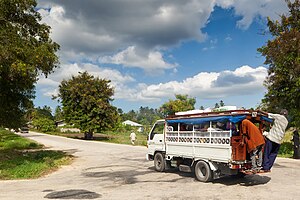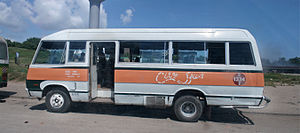
Dala dala are minibus share taxis in Tanzania. These converted trucks and minibuses are the primary public transportation system in the country. While the name originates from the English word "dollar", they are also referred to as thumni.
Before minibuses became widely used, a truck with benches placed in the bed was the typical Tanzanian privately owned public transport. Called chai maharagwe, these were popular and also used to transport and deliver goods along the route c. 1990.
While dala dala may run fixed routes picking up passengers at central locations, they will also stop anywhere along their route to drop someone off or allow a prospective passenger to board.
In contrast to most of these minibuses, in Dar es Salaam some dala dala are publicly operated as of 2008.
History in Dar es Salaam

The dala dala developed as illegal taxis in Dar es Salaam, the largest city in Tanzania, due to a deteriorating system of government-run public transport in an environment of rising demand for such services. Between 1975 and 1983, the year dala dala were legalized, the number of buses operating in Dar es Salaam declined by 36% while the population increased by around 80%. In 1983, the government transport company was allowed to sub-contract to private entities, but due to high tariffs, this did little to substantially increase the numbers of licensed dala dala.
Further reforms in the late 1990s caused the amount of legal minibuses to swell, and between 1991 and 1998 their numbers rose by 450%. Large amounts of pirate minibuses continued to exist, however, and in 1998 it was estimated that these comprised nearly half of all dala dala in operation. By 1998 dala dala had almost completely superseded government run public transport; in that year a total of 12 government operated buses plied the streets. Around that time there were somewhere between 7,650 and 6,300 dala dala in operation.
Conductor

Dala dala are often operated by both a driver and a conductor. Called a mpigadebe, the name for dala dala conductors literally means "a person who hits a debe" (a 4-gallon tin container used for transporting gasoline or water) in reference to the fact that conductors will hit the roof and side of the van to attract customers and notify the driver when to leave a station.
Regulation
These vehicles for hire have their routes allocated by a Tanzanian transport regulator, Land Transport Regulatory Authority (LATRA), but syndicates (informal groups that fix fares, collect dues, and manage stations) also exist. Prior to 1983, all forms of privately owned public transport were illegal in Tanzania, and as of 1991 and 1998 at least half of all dala dala continued to operate without a license.
In 2002 it was noted that the dala dala market "seems to remain under conditions close to classical perfect competition."
See also
References
- ^ Thoughts On Dala Dala Buses isteptanzania.wordpress.com, May 29, 2009
- ^ Tripp, Aili Mari (1997). "The Daladala Bus Wars". Changing the Rules: the Politics of Liberalization and the Urban Informal Economy in Tanzania. UNIVERSITY OF CALIFORNIA PRESS. Retrieved June 29, 2012.
- Travel Guide to Zanzibar zanzibar.org
- "How many people can you fit into a dala-dala". How many people can you fit into a dala-dala. Retrieved 2011-06-12.
- ^ Rizzo, Matteo (2002). "Being taken for a ride: privatisation of the Dar es Salaam transport system 1983–1998" (PDF). The Journal of Modern African Studies. 40 (1): 133–157. doi:10.1017/s0022278x01003846.
- ^ Stuck in Traffic; Urban Transport in Africa (page 9) Ajay Kumar & Fanny Barrett. Africa Infrastructure Country Diagnostic in cooperation with the World Bank, January 2008. Draft Final Report.
- Barrentt & Kumar, Page xii